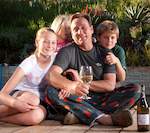This outlook pretty much describes the Veller home. The original farmhouse has been converted into a Montessori school. The couple and their three children (Rourke and his two sisters Pier and Lara) moved up the hill to a house originally built for Bernhard Veller's parents. It’s an eyrie among the vineyards, an open-plan home with expansive views across Durbanville Valley to the Stellenbosch mountains.

They’re nature lovers. Among the family pets (including a Staffie named Roxy and a cat called Yoda) is Lucky, the three-legged springbok. 'We reared him after the dominant ram in the herd tried to take him out as a newborn. He rules the roost; he's "tame" but you have to watch those horns!'
One of Bernhard's favourite relaxation spots is on the wooden deck with a glass of something vinous, spotting birds in the fynbos planted against the retaining wall above their pool. The pool itself is au naturel, using plants as a natural filter for the borehole water that fills it.
At 25 metres it's designed for lengths: the family are keen swimmers. One end of the pool opens onto a sandy beach in miniature: it's where Bernhard makes his braai fire, unfolding camping chairs and exhorting everyone to make themselves at home. It's reminiscent of the outdoor lifestyle they love at their holiday house on the Breede River.
He’s been flush with braai wood of late. In 2004 he embarked upon a replanting programme, systematically replacing most of his leafroll infected vines (a common problem in the Cape amid ongoing industry attempts to ensure virus-free plant material). 'Buying grapes is always an option but the only way to really control the quality is to manage your own.'
Results vindicated the investment. In 2009 Nitida, with its small production of around 10 000 cases, was named top producer at the national Michelangelo Awards wine show. We were stunned: we won gold or double gold with nine of the 11 wines we entered.'
The 2009 Nitída Calligraphy also won the 2010 Diners Club Young Winemaker of the Year award for RJ Botha, Nitída's winemaker since 2009. 'It was the first vintage since 2004 made entirely from our own fruit after starting the replanting programme, so we were delighted.'
Bernhard and Peta share an inclusive nature. Most who have worked at Nitida have been part of life on the farm since the beginning. Klaas now drives a slightly more modern version of Pufford. Housekeeper Joyce, who came to Durbanville from Kuruman in the Northern Cape 11 years ago, is part of the family. Her daughter Mamokete goes to school with Lara and the two lively little girls lap up Bernhard's rough and tumble.
There is a strong sense of place on Nitída, of people, their history and their symbiotic relationship to the natural world. It's reflected in the names and liveries of the wines.
The farm is named after the indigenous Protea nitida, commonly known as the waboom (wagon tree). A few plants grow up on the hill despite the vegetation being mainly the highly-threatened West Coast Renosterveld, which the Vellers are trying to conserve. The Protea coronata lent its name to their premium white blend.
Research revealed that the leaves of the Protea nitida used to be boiled up with rusty nails (or any small rusted farm implements) and candy to produce the ink used to write many of the memoirs of the early Voortrekkers at the beginning of the nineteenth century; hence the name Calligraphy. Further exploration brought them to the Latin nitidus, meaning 'bright, shiny, healthy, refined, cultured', resulting in Bernhard's Guild auction wines Decorous (good taste, refinement) and Aureus (describing the rich golden colour).
With the trademark Veller combination of intellectual curiosity (Bernhard) and creative flair (Peta), they actually tested the old Cape ink 'recipe', and the beautifully subtle shades of browns, charcoals, greys, greens and burgundies produced were used for the watercolour sketches that make the Nitida website vintage Veller: an innovative, personalised work of art, hand-crafted, with love.
 Barbecued beef sirloin with three spontaneous salads recipe by Bernhard Veller....
Barbecued beef sirloin with three spontaneous salads recipe by Bernhard Veller.... Roast herbed chicken and Mediterranean vegetables on ciabatta with potato salad recipe by Bernhard Veller....
Roast herbed chicken and Mediterranean vegetables on ciabatta with potato salad recipe by Bernhard Veller....